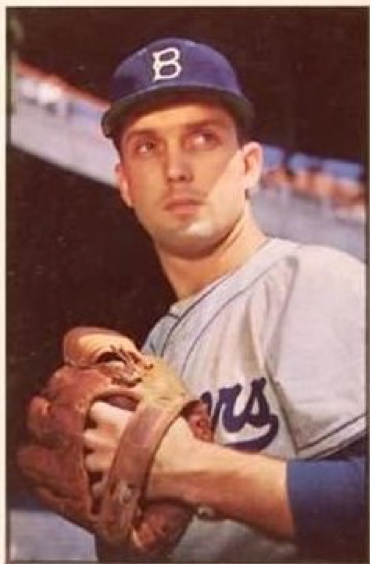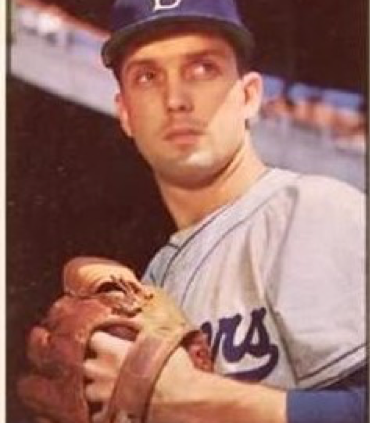October 2, 1953: Dodgers’ Carl Erskine sets World Series record with 14 strikeouts
 When Game Three of the 1953 World Series began, Carl Erskine was looking for redemption. By the time it had finished, Erskine had not only gotten redemption – he had broken one of the most cherished records in World Series lore.
When Game Three of the 1953 World Series began, Carl Erskine was looking for redemption. By the time it had finished, Erskine had not only gotten redemption – he had broken one of the most cherished records in World Series lore.
The 1953 Series marked the seventh World Series appearance for Erskine’s Brooklyn Dodgers franchise, and the fifth matchup since 1941 between the Dodgers and the New York Yankees. The Dodgers, who were still looking for their first World Series championship, had come closest in 1952, taking the Yankees to the seven-game limit. Now, in 1953, they faced the Yankees again with one of the strongest teams in franchise history. Its 105 wins in 1953 would be the most for a Dodgers team until the 2019 Los Angeles Dodgers won 106 (the club also won 106 games in 2021), and the ‘53 team’s .682 winning percentage remains the Dodger franchise’s best since 1900 except for the .717 mark (43-17) that the club posted in the pandemic-shortened 2020 season.
Erskine had led the 1953 Dodgers mound staff with a 20-6 record, and he was manager Chuck Dressen’s choice to start Game One against the Yankees’ Allie Reynolds (13-7) at Yankee Stadium. The outing was a total disaster for Erskine; he walked three batters, surrendered two triples, and gave up four runs in the first inning before being lifted for a pinch-hitter in the top of the second. The Dodgers lost, 9-5; after dropping Game Two as well (4-2), the they were desperate for a win as the Series shifted to Ebbets Field for Games Three, Four, and Five.
Despite Erskine’s horrid Game One appearance, his manager had not lost faith in him.
“Dressen came to me after that ballgame [Game One],” he recalled, “and he said, ‘I know something about you. You’ve come back on short rest despite the fact that you’ve had arm trouble. … I want to bring you back in the third game.’ And I was dee-lighted. You don’t often get that second shot that quick. And probably never before or since have I had as much determination as I had that day, and I told Duke [Snider] and Campy [Roy Campanella], ‘I’m going to pitch every inning like it’s my last, and these guys are not going to jump on me early.’”1
Erskine started Game Three strongly, striking out Gil McDougald and Joe Collins to begin the game. Hank Bauer grounded out to end the inning. In the second, Erskine issued two walks but got both Mickey Mantle and Phil Rizzuto on called third strikes. He recorded two more strikeouts in a one-two-three third: his mound opponent, Vic Raschi (13-6), and Collins (for the second time). In the fourth he allowed Yogi Berra to reach base via a hit by pitch, but fanned Mantle for his seventh strikeout of the game.
Through four innings Erskine had yet to allow a hit, but Raschi, who had defeated the Dodgers twice in the 1952 World Series, was tough as well, with only two hits allowed in four shutout innings. The Yankees broke through in the top of the fifth; Billy Martin and Rizzuto opened the frame with infield singles; both runners moved up on Raschi’s sacrifice bunt, and Martin scored on a hard single by McDougald that was knocked down by Dodgers third baseman Billy Cox. Erskine escaped the jam with no further damage, striking out Collins for the third time and getting Bauer to bounce out to second. The Dodgers tied the game in the bottom of the inning when Jackie Robinson doubled, moved to third when “Jackie, dancing off second, made Vic Raschi balk,”2 and then scored on a push bunt by Cox. “I did it on my own,” said Cox, explaining that the bunt was not a squeeze play. “ You don’t have to tell Jackie to run when he sees you’re going to bunt.”3
After Erskine held the Yankees scoreless in the top of the sixth (with two more strikeouts, including Mantle for the third time), the Dodgers took a 2-1 lead in the bottom half when Duke Snider singled, Gil Hodges walked, and Robinson drove home Snider with a single to left.
Through six innings, Erskine had recorded 10 strikeouts, only three short of the World Series record set by Howard Ehmke in Game One of the 1929 Series against the Cubs.
In the seventh, an inning in which neither team scored, Erskine failed to record a strikeout for the first time. He fanned Collins for the fourth time to open the eighth, but then gave up a single to Bauer before hitting Berra with a pitch for the second time in the game to put runners on first and second. Erskine got the second out by fanning Mantle – also for the fourth time – to give him 12 strikeouts in the game, but Gene Woodling singled to center to score Bauer with the tying run.
Raschi retired Hodges to open the bottom of the eighth, bringing up Roy Campanella. The Dodgers catcher had badly bruised his hand in Game Two and had been considered a doubtful starter for the third game. Robinson said later that as Campanella took his stance, Yankees manager Casey Stengel was pointing to his left ear, and he was yelling at Raschi, “Stick it in his ear, stick it in his ear.” Instead, wrote Dave Anderson, “Roy stuck Vic Raschi’s first pitch into the left field stands”4 to give the Dodgers a 3-2 lead. “You fellows told me Campanella was dead,” Stengel said after the game. “If he’s dying I didn’t see it out there today. If he had a good hand, he’d a hit that home run ball 80 miles.”5
Raschi retired the side in the eighth without allowing any more runs, and Erskine took the mound for the ninth inning with a one-run lead, unaware that he was one strikeout short of the single-game World Series record. Don Bollweg, pinch-hitting for Rizzuto, was the first hitter. Erskine, who related that he had faced Bollweg in the Texas League, “struck him out on all fastballs, and I did not know that tied a record, though the crowd was really frenzied by that time.”6 The paid attendance of 35,270 was the largest to ever see a World Series game at Ebbets Field to that point. (The record was broken the next day.)
Johnny Mize, batting for Raschi, was the next hitter. Mize had been a Yankee hero in the 1952 World Series with three home runs off Dodgers pitching – one of them a three-run shot off Erskine, who recalled,
John Mize had a unique quality of being a power hitter and having a very good concept of the strike zone. … And I was not thinking about strikeouts. I was thinking about giving him my best shot. He took two well-placed curveballs … and then I almost made a mistake. I wanted to get a fastball up and in on him, and I got it up, but I got it up over the plate, and he had a rip, a really had a cut, but he fouled it back, ‘cause I had good stuff that day. I could see John’s expression of ‘That was it, darn it.’ Then we came right back with another overhand curve, probably the worst swing I ever saw Mize have at a ball, and then the crowd erupted, and I will tell you for the first time – and I didn’t know why because I didn’t know about the record – but I turned and faced center field to gain my composure because I had a sensation about that strikeout that moved me emotionally.7
Mize’s strikeout gave Erskine the single-game record with 14, but there was still one out to go. Perhaps drained by emotion, Erskine walked pinch-hitter Irv Noren (batting for McDougald) on four pitches. That brought up Collins, who had struck out in each of his four previous plate appearances. Collins later told Erskine that his Yankee teammates were razzing him about getting into the record books with five strikeouts. (Yankees pitcher George Pipgras held the record with five strikeouts in Game Three of the 1932 series against the Cubs.) But after getting to two strikes, Collins tapped to Erskine, who threw him out to end the game.
The 1953 World Series would ultimately last six games. Facing the Yankees for the third time with the Dodgers trailing three games to two, Erskine lasted four innings and allowed three runs in a no-decision; the Yankees won, 4-3, for their fifth consecutive World Series championship. Erskine’s strikeout record would be broken in 1963 (by Sandy Koufax with 15); Bob Gibson fanned 17 in Game One of the 1968 series for the all-time World Series mark to date. But for one day in 1953, Carl Erskine had reached the pinnacle.
SOURCES
In addition to the sources cited in the Notes, the author consulted Baseball-Reference.com, Retrosheet.org, and the following:
Daley, Arthur. “Sports of the Times: Fantasy in Flatbush,” New York Times, October 3, 1953: 21.
Effrat, Louis. “Dodgers Did Most of Their Damage Against Bad Balls, in Raschi’s Opinion,” New York Times, October 3, 1953: 21.
“Game Three: Bums Brace on Erskine’s Record 14-Strikeout Feat,” The Sporting News, October 14, 1953: 11.
Spink, J.G. Taylor. Baseball Guide and Record Book 1954 (St. Louis: Charles C. Spink & Son, 1954).
NOTES
1 Peter Golenbock, Bums: An Oral History of the Brooklyn Dodgers (New York: G.P. Putnam’s Sons, 1984), 362.
2 “Robinson Starts to Find Target,” Brooklyn Daily Eagle, October 3, 1953: 9.
3 “Robinson Starts to Find Target.”
4 Dave Anderson, “Campy Has Last Laugh on Stengel,” Brooklyn Daily Eagle, October 3, 1953: 9.
5 Joe Lee, “Yanks Sing Praises of Erskine’s Stuff,” Brooklyn Daily Eagle, October 3, 1953: 9.
6 Golenbock, 362.
7 Golenbock, 362.
Additional Stats
Brooklyn Dodgers 3
New York Yankees 2
Game 3, WS
Ebbets Field
Brooklyn, NY
Box Score + PBP:
Corrections? Additions?
If you can help us improve this game story, contact us.


